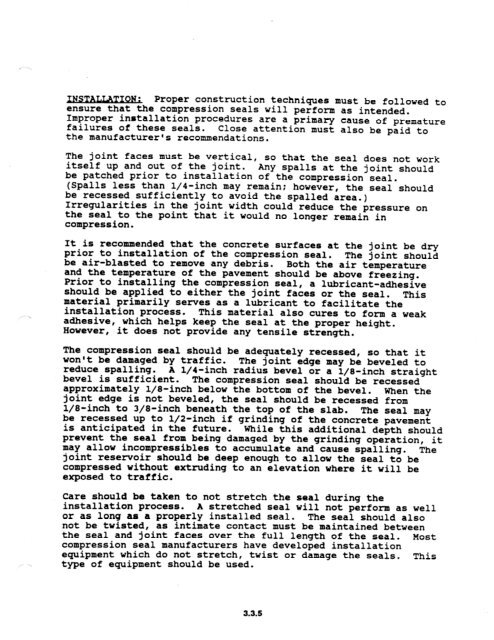chapter 3 rigid pavement - DOT On-Line Publications - Department ...
chapter 3 rigid pavement - DOT On-Line Publications - Department ...
chapter 3 rigid pavement - DOT On-Line Publications - Department ...
You also want an ePaper? Increase the reach of your titles
YUMPU automatically turns print PDFs into web optimized ePapers that Google loves.
.<br />
ST-ON. Proper construction techniques must be followed to<br />
ensure that the compression seals will perform as intended.<br />
Improper installation procedures are a primary cause of premature<br />
failures of these seals. Close attention must also be paid to<br />
the manufacturer's recommendations.<br />
The joint faces must be vertical, so that the seal does not work<br />
itself up and out of the joint. Any spalls at the joint should<br />
be patched prior to installation of the compression seal.<br />
(Spalls less than l/4-inch may remain; however, the seal should<br />
be recessed sufficiently to avoid the spalled area.)<br />
Irregularities in the joint width could reduce the pressure on<br />
the seal to the point that it would no longer remain in<br />
compression.<br />
It is recommended that the concrete surfaces at the joint be dry<br />
prior to installation of the compression seal. The joint should<br />
be air-blasted to remove any debris. Both the air temperature<br />
and the temperature of the <strong>pavement</strong> should be above freezing.<br />
Prior to installing the compression seal, a lubricant-adhesive<br />
should be applied to either the joint faces or the seal.<br />
material primarily serves as a lubricant to facilitate the This<br />
installation process. This material also cures to form a weak<br />
adhesive, which helps keep the seal at the proper height.<br />
However, it does not provide any tensile strength.<br />
The compression seal should be adequately recessed, so that it<br />
won't be damaged by traffic. The joint edge may be beveled to<br />
reduce spalling. A l/4-inch radius bevel or a l/b-inch straight<br />
bevel is sufficient. The compression seal should be recessed<br />
approximately l/a-inch below the bottom of the bevel. When the<br />
joint edge is not beveled, the seal should be recessed from<br />
l/a-inch to 3/8-inch beneath the top of the slab. The seal may<br />
be recessed up to l/a-inch if grinding of the concrete <strong>pavement</strong><br />
is anticipated in the future. While this additional depth should<br />
prevent the seal from being damaged by the grinding operation, it<br />
may allow incompressibles to accumulate and cause spalling.<br />
joint resenroir should be deep enough to allow the seal to be The<br />
compressed without extruding to an elevation where it will be<br />
exposed to traffic.<br />
Care should be taken to not stretch the seal during the<br />
installation process. A stretched seal will not perform as well<br />
or as long as a properly installed seal. The seal should also<br />
not be twisted, as intimate contact must be maintained between<br />
the seal and joint faces over the full length of the seal. Most<br />
compression seal manufacturers have developed installation<br />
equipment which do not stretch, twist or damage the seals. This<br />
type of equipment should be used.<br />
3.3.5
















